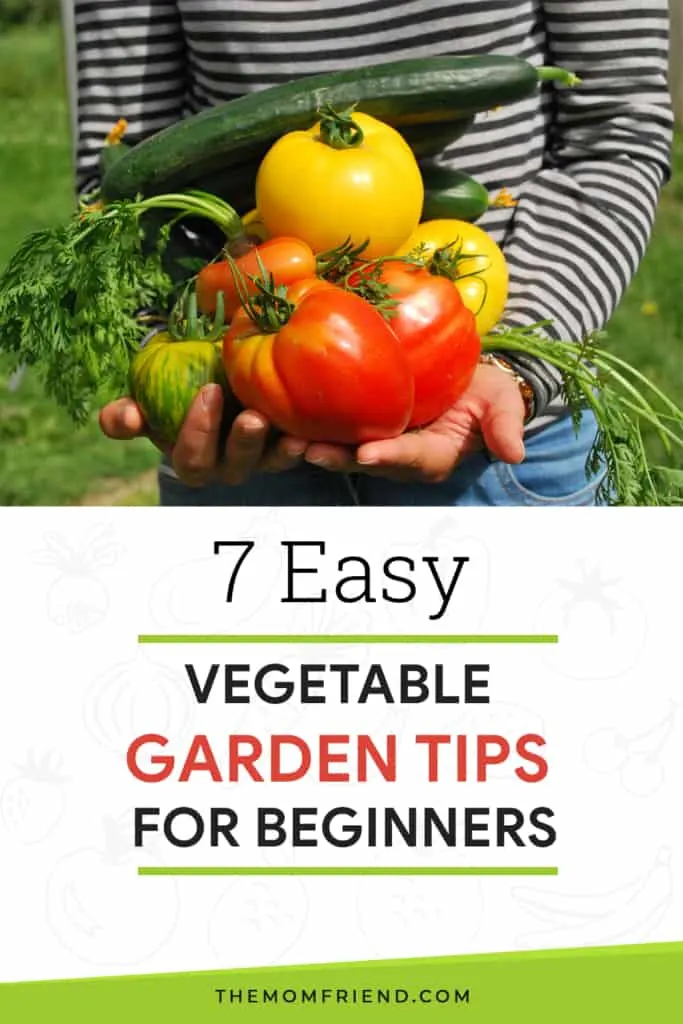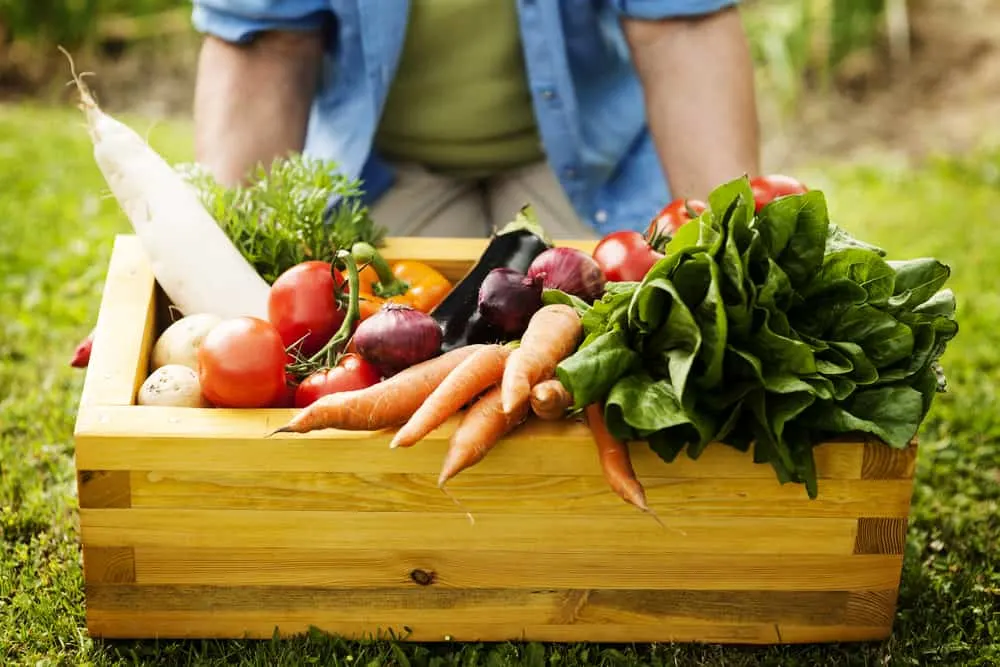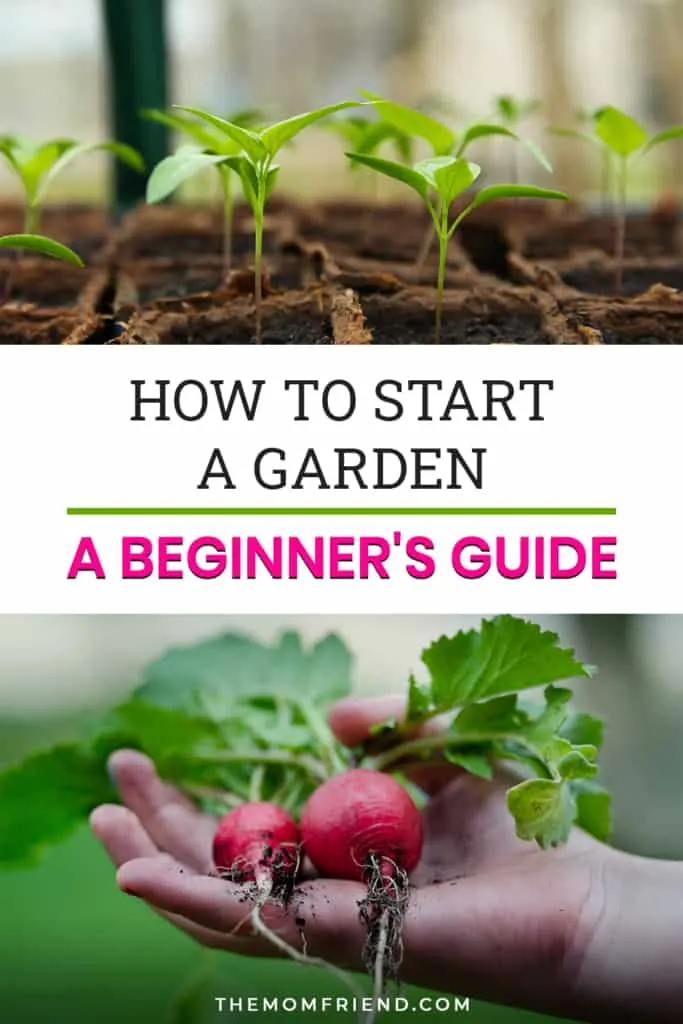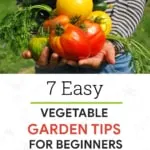Have you dreamed of a beautiful vegetable garden, but worry that your thumb isn’t green enough? Don’t let a lack of gardening experience keep you from fresh veggies at your fingertips. Here are 7 easy vegetable garden tips for beginners, so you can get growing as soon as possible. You will learn vegetable gardening basics that are sure to help you grow a vegetable garden that neighbors will envy.
New gardeners will definitely want to check out these easy vegetable gardening tips for beginners to help plan, prep, and grow your first vegetable garden. Read through to the bottom for list of easy to grow vegetables perfect for the first time gardener.

Vegetable Gardening Tips & Tricks for Beginners
Here are 7 easy vegetable garden tips for beginners to help you get off on the right foot. Here is what you need to know.
1. Know your climate.
One of the most important things to know prior to planning your vegetable garden is your climate. Some plants do better in certain zones than others. Your designated zone will also determine your planting time. You never want to plant vegetables until the threat of frost has passed and temperatures are a steady 60 degrees or higher.
When you know your climate well, you can be sure you don’t plant too soon and that you are also choosing plants ideal for your growing conditions.
2. Start with a solid plan.
Choose 3 to 5 vegetable plants to start. While you might be excited to go all out, scaling down and steadily focusing on a handful of plants is better. This way, you can truly master the plants you are growing and not spread yourself too thin.
When choosing vegetable plants, check to make sure they are compatible with each other. Not all veggie plants play nice together. This doesn’t mean that you can’t plant these vegetables together necessarily, it just means you will need to separate them in the garden.
3. Work with the space you have.
Your vegetable plants will need proper space to grow and possibly climb. As you choose your plants, be sure you have the proper amount of space for them. Cucumbers, peas, and beans will need to grow vertically, while vegetables such as tomatoes and peppers will need ample space to spread out.
Before you fill your trunk with vegetable plants, be sure you have adequate space for what you are buying. If you are short on space, remember that container gardening is always an option with some kinds of vegetable plants such as chili peppers and cherry tomatoes.
4. Start with strong seedlings.
If you are a first time vegetable gardener, it is easier to start with seedlings instead of seeds. Growing vegetables from seeds often means starting seeds indoors prior to the last frost of the season, which can end up being a great deal of work. Plus, you will need to hassle with transplanting.
Instead, start with strong seedlings from a reputable gardening center. Look for seedlings that are bright in color, with strong stems and in nutrient rich soil. This way, you can be sure you are giving your garden a strong start with plants that are ready to thrive.
5. Try these tips for veggie plant TLC.
There are a few things you can do to help keep your vegetable plants happy as they grow. This includes applying mulch around the base of the plant to help keep roots cool and the soil moist, giving deep waterings of 2 inches of water per week, and using a food safe liquid plant food 3-4 weeks after planting. Practice regular weeding, offer plants support (such as tomato cages and trellises) and keep bugs at bay to encourage healthy plants.
You always want to make sure you offer your plants full sun. This means a solid 6-8 hours of direct sunlight per day. You also want to plant in an area with well draining soil. This means that after a storm the water doesn’t puddle. Loose soil can help plant roots spread and grow as they need to with ease.
6. Harvest continually.

Once your vegetables start growing, harvest continually. You might be tempted to leave vegetables on the vine or stem hoping they grow bigger, but the truth is you should pick sooner. This will encourage the plant to grow more produce and can lead to a healthier plant.
7. Be prepared to offer first aid.
Vegetable plants can experience a few ailments such as stem breakage, brown foliage, and foliage stress. Be sure you have the supplies you need to offer care. This includes plant stakes and plant ties to offer the plant support, and plant tape to help seal any damaged stems. You can snip off dead foliage as you see it, which will encourage the plant to divert resources to its healthy parts.
So which vegetables are great for beginners?
Certain vegetable plants are ideal for newbies, while others should be avoided. Let’s take a look at the best vegetable plants for beginners.
- Green Beans
These tend to go wild on their own with a proper trellis and little intervention. They offer a high yield of produce as well. - Tomatoes
Tomatoes are a hardy plant that do well in most conditions and climates. Plus, one plant can yield 8-10 pounds of tomatoes! - Peppers
When it comes to peppers you have dozens of varieties to choose from. They do well in most climates and don’t require a ton of fuss. They can even be grown in pots! - Carrots
Growing carrots is as easy and planting your carrot seeds and letting them grow! They require minimal care and are fun to harvest. - Peas
Peas are another easy to grow vegetable that will be ready to pick early in the season. One plant alone will give you high yield. - Zucchini
Who doesn’t love zucchini? This is a vegetable that requires little fuss and will grow HUGE! - Cucumbers
Cucumbers are very forgiving and will do well in most climates. Plus, one plant can give you a huge harvest.
In addition to these vegetables, consider leafy greens. Whether you plant spinach, collard greens, kale, or lettuce, they are fairly easy to grow.
Some of the plants you should avoid as a new vegetable gardener include those that require a great deal of space, are grown from crowns, or have lengthy growing seasons. These vegetable plants include: asparagus, eggplant, corn, pumpkins, large squash varieties, and artichokes.
Are you ready to grow your favorite veggies? Give these 7 easy tips for beginner vegetable gardeners a try, and see what you can grow!
Other Trending Posts



